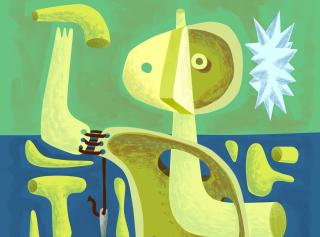Advertisement
Today is post-op day #10. Objectively, all is progressing typically and well. But the surgeons who make such general objective guidelines see their patients asleep, then highly medicated, and then not for six more weeks. The day-by-day and inner landscape is more varied and challenging.
This, a knee replacement, was my eighteenth surgery. Fifteen of those surgeries were due to Stickler syndrome, a chronic connective-tissue disorder. There will be many more surgeries.
The least of the mundane challenges are routine bodily processes that become major Daily Events. I haven’t tolerated pain medicine well at all this time around, so I’m under-managing pain to avoid nausea and migraines. You can imagine how pleasant that is.
I saw huge progress yesterday. With the physical therapist holding my flattering safety belt, I walked down the hallway and back twice without a walker or crutches. I did the stairs for the first time since making a tearful and slow ascent when arriving home from the hospital. Now I can get out—and presumably back in. Today I’m terribly sore and hobbling around on my walker and sitting in my recliner.
I know a long recovery looms ahead. There is terrain to be crossed in the visible, physical realm. But there remains the inner realm, the recesses of mind and spirit that must be traversed before emergence. Those are darker, more hidden places that demand their due, even in a routine and elective procedure that is so very common. The patient-education pamphlets conveniently omit this aspect of the ordeal. It’s an inside job.
Recovery is little victories: forgetting the walker and taking two awkward, largely ineffectual, yet independent steps. It’s the physical therapist bending my knee until near rupture (which, admittedly, isn’t even yet a 90-degree bend). He asks if I’m going to cry. Not yet, I say, though the truth is already out. He says yesterday an old man kicked him out of the nursing home and said to never come back. I’d like to meet that guy.
It is hinges of time swung strangely open, both empty and full. It is the fine line between medicine and poison, exertion and rest, powerlessness and agency, dogged fight and acceptance. That’s the work we all do anyways, but in this moment and space of mine, the veil of distraction has been pulled aside from the stark nakedness of the task.
I’ve been surprised at how good my kids are at jigsaw puzzles. I discovered it during our vacation earlier this summer. I have never liked recreational puzzles. There is enough in my life that I can’t figure out already. Yet I bought puzzles in anticipation of needing sedentary activities that I could do while exceedingly high on narcotics. I like to be prepared.
Yesterday morning, I was finishing a Charles Wysocki kitschy-Americana, Buffalo brand, 300-piece puzzle while painfully sober and slightly queasy. I’m sure it’s what the artist had imagined for the piece. The kids had made much progress the night before. I finished the puzzle.
We took it partially apart before the kids came home. Thankfully my mother-in-law had the good sense to actually do this. I had suggested it by way of justifying my intent to finish said puzzle without the kids, but couldn’t bring myself to take apart the pieces. She did the dirty work. The careful observer might have noticed that the puzzle was less complete at 3:30 in the afternoon than at 8:30 that morning when the kids left for summer day camp.
But it worked. The kids finished it. Our 4-year-old, a surprisingly enthusiastic and adept puzzler, proudly snapped in the last pieces. “It’s beautiful,” he said with a tone of near reverence, not without a bit of pride.
Here we are, taking apart the pictures and pieces of our lives to reassemble them, hopefully into something recognizable, if not beautiful. Rending flesh and breaking bone and stitching it together again, sometimes with reverence, sometimes with a little pride, not without sorrow or embarrassing bodily functions that are Major Events and Conversations.
We are trying to find patterns of color, light, shape, puzzling our way alone, puzzling our way together.
This essay is adapted from an August 21, 2015 Facebook post.
